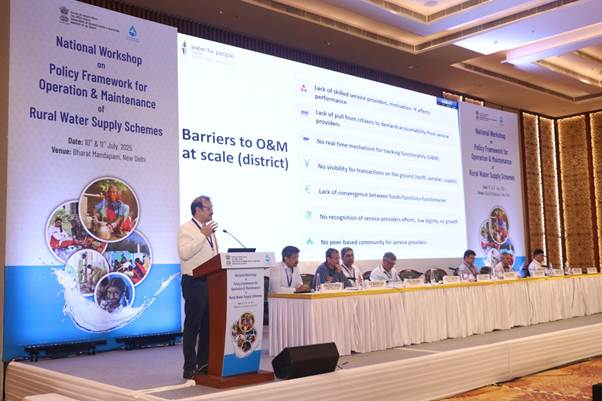National Workshop Charts Tech-Driven Future for Rural Water Scheme O&M
Shri Ashok K.K. Meena, Secretary, DDWS, opened the day with a powerful address underscoring the transformative role of mobile technology and the JAM Trinity (Jan Dhan, Aadhaar, Mobile) in rural water management.

- Country:
- India
Marking a pivotal step toward strengthening India’s rural water infrastructure, the two-day National Stakeholder Consultation Workshop on the “Policy Framework for Operation & Maintenance (O&M) of Rural Piped Water Supply Schemes” concluded today with a resounding call to make technology, transparency, and accountability the pillars of water governance.
Organized by the Department of Drinking Water and Sanitation (DDWS) under the Ministry of Jal Shakti, the workshop gathered over 250 participants, including senior government officials, public health engineers, Jal Jeevan Mission (JJM) directors, district-level administrators, WASH sector partners, and NGOs. The event was a strategic knowledge-sharing platform to shape India’s O&M roadmap as JJM transitions into its sustainability phase.
Day 2: Technology at the Core of Governance
Following Day 1’s discussions on institutional frameworks, community engagement, and financial models, the second day centered on digital innovation and emerging technologies that are revolutionizing rural water service delivery.
Shri Ashok K.K. Meena, Secretary, DDWS, opened the day with a powerful address underscoring the transformative role of mobile technology and the JAM Trinity (Jan Dhan, Aadhaar, Mobile) in rural water management.
“Mobile phones are perhaps the best IoT sensors already in human hands,” he remarked, highlighting the need for real-time, two-way data flow between citizens and service providers. He praised ongoing efforts by States and Union Territories to develop localized digital water ecosystems, calling for their scale-up and integration with national platforms like PM Gati Shakti and the JJM Dashboard.
Session 1: Data Streams to Decision Engines
This session explored how real-time data, AI, and IoT-enabled systems are enabling efficient and predictive maintenance of water infrastructure. Technologies presented included:
-
Supervisory Control and Data Acquisition (SCADA)
-
IoT-based pressure and flow sensors
-
AI-powered decision support systems (DSS)
-
Energy optimization tools for pump management
Speakers emphasized that digital governance is no longer a support tool but the spine of O&M, and India-specific frugal innovations—like app-based dashboards and remote data loggers—were spotlighted for their scalability and cost-effectiveness in rural settings.
Session 2: GIS and Space Tech Transformations
A high-impact thematic session focused on GIS and space technology use in rural water governance. Participating institutions included:
-
Madhya Pradesh PHED, showcasing its Jal Rekha platform for real-time asset monitoring.
-
BISAG-N, demonstrating applications of the PM Gati Shakti framework in asset mapping.
-
NRSC–ISRO, detailing satellite-based groundwater mapping and sustainability forecasting.
-
AIILSG, highlighting GIS tools for predictive maintenance and citizen grievance tracking.
These technologies are enabling evidence-based planning, reducing operational inefficiencies, and helping align infrastructure development with local hydrogeological conditions.
Session 3: Securing the Source
Recognizing that sustainability begins at the source, this session explored Integrated Water Resource Management (IWRM) and community-based source protection models. Key highlights included:
-
Tripura’s groundwater recharge techniques, using dug wells and injection wells approved by the Central Ground Water Board (CGWB).
-
Uttarakhand’s SARRA programme, focusing on spring rejuvenation with citizen science and GIS support.
-
Jal Sanrakshan Abhiyan 2024, a national campaign promoting rainwater harvesting and inter-agency coordination.
-
Contributions from NGOs such as the Aga Khan Foundation, which is leveraging CSR funding for community mobilization under JJM.
National agencies like NWIC and CGWB presented data-sharing and planning tools, including Water Data One Platform and source sustainability inventories.
Session 4: IT Advancements Across States and UTs
This session showcased a diverse suite of digital innovations across Indian states:
-
79% of States/UTs now support digital bill payment for rural water services.
-
46% offer online tracking of new connections.
-
57% maintain consumer databases, enabling targeted outreach and demand management.
-
However, only 14% have linked water quality testing systems to WQMIS, spotlighting a key area for policy focus and technological investment.
Participants also demonstrated geo-tagging tools, mobile-based complaint redressal, dashboard analytics, and voice-enabled citizen engagement apps.
Behavioural Insights and Panchayati Raj Engagement
Shri Vipul Ujjwal, Director at the Ministry of Panchayati Raj, introduced the MAP model (Motivation, Ability, Prompt) as a behavioral lens to drive consistent service delivery. He reinforced the role of Panchayats as the fulcrum of rural transformation, especially in operation and maintenance.
A Collective Vision: Accountability, Equity, and Resilience
The workshop concluded with closing remarks by Shri Kamal Kishore Soan, Additional Secretary & Mission Director, DDWS. He congratulated all stakeholders for their contributions and emphasized that the way forward lies in the synergistic blend of policy, people, and technology.
“Our collective goal is clear — to ensure that every rural household receives clean tap water every day, and that the system sustaining it is resilient, transparent, and citizen-centered,” he said.
The Road Ahead for Jal Jeevan Mission
As the Jal Jeevan Mission (JJM) enters its consolidation and sustainability phase, this consultation sets the tone for next-generation water service delivery. Key takeaways include:
-
Prioritizing real-time monitoring and predictive maintenance
-
Empowering Panchayati Raj Institutions (PRIs) with digital tools
-
Ensuring source sustainability through scientific planning
-
Promoting inter-agency convergence
-
Strengthening consumer engagement via mobile-first platforms
The workshop ended with a unified call for action: to embed accountability, transparency, and innovation at the heart of rural water supply systems—turning India’s water governance vision into a daily reality for millions.










